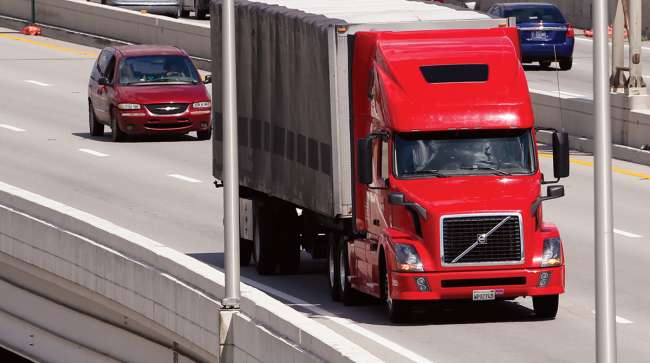Senior Reporter
Tonnage Declines 8.9% Year-Over-Year in August

[Stay on top of transportation news: Get TTNews in your inbox.]
Truck tonnage in August declined a seasonally adjusted 8.9% when compared with year-ago levels, marking the fifth consecutive year-over-year decline, American Trucking Associations said.
Additionally, the federation reported that the coronavirus pandemic is having a “profound impact” on the overall driver market.
The federation’s For-Hire Truck Tonnage Index was 107.5 in August, compared with 113.9 in July. (The index equaled 100 in 2015.) On a sequential basis, truck tonnage was down 5.6% from July.
Both the year-over-year and monthly declines in the tonnage index are a reflection of some trucking sectors continuing to struggle, Bob Costello, chief economist at ATA, said Sept. 22 when the tonnage report was released.

Costello
“The August softness suggests that freight is very uneven in the trucking industry,” Costello said of the mid-third quarter results. The trucking sectors that haul for the industrial and energy industries are not seeing the surge in freight like the consumer side of the economy, for example.
“The industrial loads tend to be heavier, so they count more in a tonnage calculation than most consumer-related loads,” he said. “Fleets hauling for retailers are generally seeing strong freight volumes. Carriers hauling heavier industrial products generally saw softer volumes in August.”
The surge on the consumer side lifted the DAT Truckload Volume Index, a measure of dry van, reefer and flatbed loads moved by truckload carriers.
The index rose 0.8% compared with August of 2019 and 1.1% compared with July, according to DAT Freight & Analytics, which operates an online marketplace for spot truckload freight.
“Volatility in shipper networks due to shifting consumer purchasing spilled over to the spot market. For instance, commercial food service is way down, but grocery purchases are up,” said Ken Adamo, chief of analytics at DAT.
The spot van rate averaged $2.22 per mile nationally in August, up 41 cents from the same month a year ago.
Freight transportation is a barometer of U.S. economic health, and trucking represents 72.5% of tonnage carried by all modes. Trucks hauled 11.84 billion tons of freight in 2019, ATA said.
But hauling goods has been a struggle. For the driver market, the annualized turnover rate at large and small truckload carriers had double-digit declines in the second quarter, ATA said Sept. 23.
Turnover at truckload carriers with more than $30 million in annual revenue fell 12 percentage points to 82% — the lowest level since late 2018.
The rate at smaller truckload carriers (less than $30 million) fell 10 points to 60% — the lowest level since the fourth quarter of 2011.
“The second quarter was a tumultuous one for trucking, and the broader economy,” Costello said. “The coronavirus had a profound impact on the driver market — particularly in the first part of the second quarter. But by the end of the quarter, we had begun to see the market tighten again as various restrictions began to be lifted.”
He said after steep drops early, the driver market began to normalize toward the end of the quarter.
“As the economy continues to recover, we should see the market for drivers continue to tighten going forward.”
The annualized turnover rate at less-than-truckload carriers was unchanged at 12% during the second quarter.
Meanwhile, researcher FTR said trucking is facing a possible problem regarding capacity and the driver shortage.

Vise
Avery Vise, vice president of the trucking division, said overall capacity challenges are likely to continue because of uncertainties surrounding the pool of current and potential professional drivers.
“There’s just a whole range of things going on, none are dramatic on their own, but they are a series of issues keeping things tighter than we expected,” he said. “It’s sort of a disjointed kind of recovery.”
He points to the difficulty new drivers face obtaining commercial driver licenses because of coronavirus-related challenges at driver training programs as well as the backlog of paperwork at state Department of Motor Vehicle offices.
Also tightening capacity is that more than 30,000 drivers have tested positive for illegal drugs, making them ineligible to drive until they complete a mandated return to duty program, said Vise, citing the new federal drug and alcohol clearinghouse for commercial drivers.
He said more than 90% of those drivers have not completed the requirements and therefore are not driving.
“Every driver who tests positive and doesn’t eventually complete the requirements to return to work, is banned and it’s only going to get larger,” he said. “All of these factors tend to make hiring and keeping drivers more difficult.”
The Drug and Alcohol Clearinghouse is a secure online database that gives employers, the Federal Motor Carrier Safety Administration, state driver licensing agencies and state law enforcement personnel real-time information about commercial driver license and commercial learner’s permit holders’ violations.
Want more news? Listen to today's daily briefing:
Subscribe: Apple Podcasts | Spotify | Amazon Alexa | Google Assistant | More




